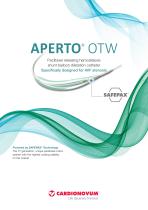
- Secondary care
- Cardiology
- PTA catheter
- Cardionovum
PTA catheter APERTO OTW peripheralballoon
Add to favorites
Compare this product
Characteristics
- Application
- PTA
- Area of the body
- peripheral
- Options
- balloon
- Total length
40 cm, 80 cm
(16 in, 31 in)- Balloon diameter
5 mm, 6 mm, 7 mm, 8 mm, 10 mm
(0.2 in, 0.24 in, 0.28 in, 0.31 in, 0.39 in)
Description
The specifically designed and exclusively CE-Mark approved high pressure DCB for the treatment of shunt stenosis.
APERTO SHUNT DCB protects AV fistulas and shunt grafts from early restenosis.
For the prevention and successful dilatation of intimal hyperplasia.
APERTO DCB promises a prolonged Dialysis access survival.
Shunt restenosis represents a common threat to the function of arteriovenous fistulas (AVFs) and shunt grafts in patients on hemodialysis. Patients often develop a consecutive neointimal hyperplasia in hemodialysis access vessels as well as along the needle puncture site.
The new APERTO DCB Paclitaxel releasing, high pressure balloon dilatation catheter provides a dual shunt treatment quality for the prevention and dilatation of intimal hyperplasia. AVF or PTFE shunt graft venous outflow lesions can be treated very successfully by the new APERTO OTW leading to a substantial reduction of hemodialysis shunt restenosis, for a prolonged dialysis access survival.
Randomized clinical study results confirm APERTO as the first choice in the AVF stenosis treatment:
APERTO AVF RCT CHINA is the first AVF RCT study to achieve statistical superiority versus High Pressure POBA in the market.
APERTO provides 2x vessel protection. APERTO optimizes the long-term anti-proliferative vessel wall protection, combined with a anti-inflammatory healing effect.
Hemodialysis vessel stenosis is typically treated by using a high pressure PTA dilatation balloon or alternatively a cutting balloon
Catalogs
APERTO OTW®
6 Pages
*Prices are pre-tax. They exclude delivery charges and customs duties and do not include additional charges for installation or activation options. Prices are indicative only and may vary by country, with changes to the cost of raw materials and exchange rates.





